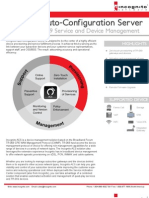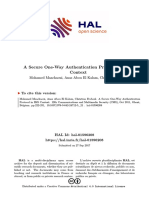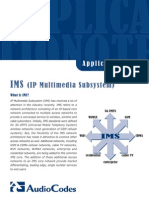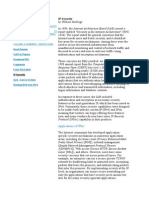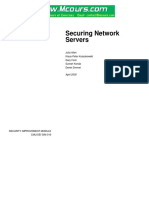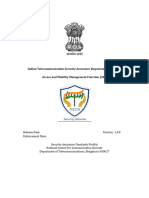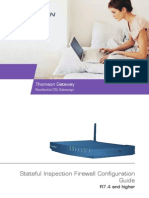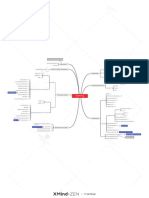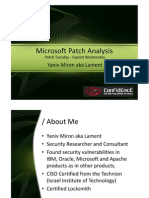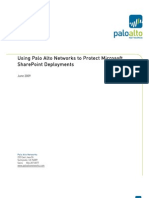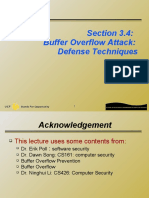Vulnerability Discovery and Analysis Within The Open Source IMS Core
Vulnerability Discovery and Analysis Within The Open Source IMS Core
Uploaded by
Badr AzizCopyright:
Available Formats
Vulnerability Discovery and Analysis Within The Open Source IMS Core
Vulnerability Discovery and Analysis Within The Open Source IMS Core
Uploaded by
Badr AzizOriginal Title
Copyright
Available Formats
Share this document
Did you find this document useful?
Is this content inappropriate?
Copyright:
Available Formats
Vulnerability Discovery and Analysis Within The Open Source IMS Core
Vulnerability Discovery and Analysis Within The Open Source IMS Core
Uploaded by
Badr AzizCopyright:
Available Formats
Vulnerability Discovery and Analysis within the Open Source IMS Core
Denver D. Abrey and Neco Ventura Department of Electrical Engineering University of Cape Town, Private Bag X3, Rondebosch 7700, South Africa Tel: +27 21 6502699, Fax: +27 21 6503782 email: {neco, dabrey}@crg.ee.uct.ac.za
Abstract-VoIP has increasingly been adopted as a preferred method of communication and continues to gain popularity. With operators looking to move to a converged service delivery platform, many are turning to IMS deployments to provide such services. Security is an essential part of any deployment, and it is beneficial to be aware of possible vulnerabilities, so they may be dealt with accordingly. This paper describes a method of locating vulnerabilities within an IMS deployment. It focuses on the Open Source IMS Core, and describes the discovery, analysis, and impact of vulnerabilities within. A technique called fuzzing is used throughout for the discovery of vulnerabilities. Index Terms ims, ims security, open source ims core, sip, sip security I. INTRODUCTION Internet Multimedia Subsystem or IMS implementations provide a unified service delivery platform for various Voice and Media related services. Voice over Internet Protocol P (VoIP) being one of the most prominent services. This would usually be complemented by a number of value-added services such as Video on Demand or streaming Internet Protocol TV (IPTV) media delivery features. As these are likely paid services, a network operator cannot afford to overlook the aspect of security within their own deployment. Security encompasses a vast number of different areas, including authorisation, authentication, integrity protection and privacy. Intrusion and attack detection and prevention systems are often also employed. These protection mechanisms operate at various layers within a given architecture. While the 3rd Generation Partnership Project (3GPP) has taken care to clearly define the requirements for security on various layers, protocol implementation is left to the developers of a particular IMS implementation. With careful programming and code auditing practices, security risks can be minimised. It is however extremely difficult to account for absolutely all possible conditions, and as such fuzzing provides a useful tool to discover remaining problems. Fuzzing involves the automated generation of random, unexpected or out of bounds data. [7] This paper begins by providing an overview of IMS security features and related protocols in sections I through V. Methods of attack and a means for discovering vulnerabilities are then discussed in sections VI and VII. Results are then presented after applying this technique to the Open Source IMS Core in section VIII and IX. II. IMS ARCHITECTURE The IMS architecture can be divided into 3 distinct layers [1]: 1. The Application or Service Layer which contains Application Servers (AS) that provide services over the IMS, and the Home Subscriber Server (HSS) 2. The Control Layer which contains a number of service subsystems, including the IMS core 3. The Transport or Connectivity Layer, which refers to the underlying mechanism via which the user equipment connects to the IMS network. Examples include IP, Multiprotocol Label Switching (MPLS), or even the Public Switched Telephone Network (PSTN) when making use of legacy devices and interworking functions.
Fig. 1. Simplified view of IMS Layered Architecture [2].
A. IMS Signalling Core The IMS Signalling Core falls within the Control Layer, and is depicted by the Call/Session Control Functions (CSCFs) block in the diagram above. The signalling core consists of the three entities described below. Proxy-CSCF: The P-CSCF is the first point of contact for the User Equipment (UE) within the IMS. Its responsibilities include authenticating user agents (UAs), and servicing requests by from UAs for access to services. [3] It acts as a
proxy, in that it may forward requests or service them internally. [4] Serving-CSCF: The S-CSCF performs session control services for the UE, and maintains session states as needed to support services for the network. [6] It also maintains direct interfaces to Home Subscriber Server (HSS) and other core elements such as charging or billing application servers. [5] Interrogating-CSCF: The I-CSCF facilitates peering between different carriers networks. Its functions include allocating an S-CSCF to a user performing a registration using the Session Initiation Protocol (SIP), and generating call records. [4] [5] B. IMS Security Architecture The IMS Security architecture is presented to provide insight into the interactions between the CSCFs and both internal and external components of the IMS.
well to the network interfaces between the HSS and CSCF components, and are thus useful attack vectors.
III. ATTACK VECTORS By analysing the IMS Core and Security Architecture described in section II, a number of attack vectors have been identified. This paper focuses only on the CSCF components within the signalling core. While Diameter interfaces are also present within the signalling core, only SIP interfaces are examined in this paper. A. External Attack Vectors As shown in Figure 2, Security Association 2 is present between the UA and P-CSCF. This corresponds directly to the SIP dialogue established between the UA and P-CSCF. Within the Open Source IMS Core, this dialogue makes use of the user datagram protocol (UDP), and the P-CSCF communicates using port 4060 to the UA when using the default configuration. Port 4060 of the P-CSCF IP address therefore presents an external attack vector. B. Internal Attack Vectors within Control Layer While the IMS Core will generally be secured from external networks, internal attack vectors still need to be considered, as malicious data may originate internally too, for example from mischievous employees of a carrier. Internal interfaces may also be available to other carriers for roaming purposes, meaning that access to these interfaces is granted to peering networks. As shown in Figure 2, interfaces between I-, S-, and PCSCF exist. These again correspond to SIP dialogs, established over UDP. All interfaces on CSCFs listen are available as attack vectors within the Control Layer. C. Application/Service Layer Attack Vectors As Application Servers (AS) require an interface to the IMS infrastructure, they will generally have to speak to the CSCF within the control layer. This usually happens as requests are routed to their appropriate AS via the S-CSCF. [4] This presents the S-CSCF interface to the Application layer as an attack vector. These attack vectors are listed in the table below, including port numbers.
TABLE I ATTACK VECTOR SUMMARY Component P-SCSCF I-CSCF S-CSCF Attackable from External networks Control Layer/Core Control and Application Layers Protocol SIP/UDP SIP/UDP SIP/UDP Port 4060 5060 6060
Fig. 2. IMS security architecture showing the relationship between internal and external components, including their grouping.
The diagram above shows the 5 different security associations present in a simple IMS deployment. These are described below. 1. Provides mutual authentication between UE and IMS. The process is delegated to the S-CSCF, but the HSS generates the keys and challenges. [5] 2. Secure link and security association between UE and P-CSCF facilitating authentication of data origin. 3. Provides security within the core network for the interface between HSS and S-CSCF. 4. Provides security between P-CSCF and SIP capable nodes in other networks when UE is roaming. 5. Provides security between P-CSCF and other SIP nodes when UE is not roaming. Security associations 2-5 are of interest as they correspond
The above applies to the Open Source IMS Core with a default configuration.
IV. FUZZING Fuzzing was chosen as the technique to be used for vulnerability detection. Fuzzing is an important part of secure development lifecycle, and also a popular method of testing used by security researches and software developers. [8] This technique works by automating the generation of random or unexpected data. For this to be successful however, it should be at least partly compliant with the protocol under investigation. The reason for this is that we want the application (or server) under test to assume that the data is valid and treat it as such. [7] For example, sending random characters and integers, or even binary to a SIP server will (or should) result in the traffic merely being discarded as it is not intelligible. While this may yield some results from a poor implementation, it is unlikely that this traffic would make it past rudimentary validity checks. A. Types of Fuzzers Fuzzers are applicable in a number of different situations. These include file, network, general and custom fuzzers. These can be further divided into stateful and stateless fuzzers. [8] Stateful fuzzers attempt to intelligently traverse execution paths by exploring the state-space of a given test-scenario. In network fuzzers, this means exploring the state-tree of a given protocol. This allows the fuzzer to locate bugs that wouldnt usually be triggered by invalid data alone, but require previous steps to put the application under test into the correct state to trigger the bug. Further features such as process monitoring may also be present. This means that the fuzzer is able to detect whether the process under test has crashed or stopped responding, and restart it as necessary. These occurrences are logged (and possibly even a core dump is retained), and the process continues without user interaction. [8] B. Open Source Fuzzing Tools There are many fuzzing utilities available, and a large number are open source. For the experiments described in this paper the VoIPER VoIP security testing toolkit [9] was used. This consists of a number of SIP-specific fuzzing utilities and auxiliary tools designed to test SIP implementations. It makes heavy use of the Sulley fuzzer development and testing framework. [10] Both are written in python and designed to be extensible making them ideal for IMS targeted testing. Sulley features include state tracking, automated-data generation features and built-in support for network fuzzing. It also includes utilities to do process monitoring, which the VoIPER tool has built on. V. SIP FUZZING The VoIPER suite includes a number of fuzzing utilities
designed to test different parts of the SIP protocol. These are listed and detailed below. A. SDP Fuzzer This attempts to locate bugs related to SDP processing within the SIP server by fuzzing various SDP parameters within SIP requests. B. SIP ACK Fuzzers There are two fuzzers included which attempt to locate bugs related to the way an implementation acknowledges SIP requests and responses. One semi-stateful which attempts to set up the session to the target in such a way that it would expect an ACK. The second simply sends ACKs without any regard for the targets state. ACKs are sent whether they are expected by the application or server under test or not. C. SIP CANCEL, REGISTER, NOTIFY and SUBSCRIBE Fuzzers These attempt to find bugs by sending each of the above SIP requests with each field set to various oversized and invalid values. The random data generation is performed by the Sulley framework. D. SIP INVITE Fuzzer As SIP INVITE requests contain a large number of attributes and may be processed in a number of ways, four INVITE-specific fuzzers are included. The first two manipulate various attributes, setting them to oversized and invalid values. The third iterates through all possible extended attributes applicable to the INVITE request. This is referred to as the Common Options variant of the SIP INVITE test in section VII. These appear on the first line of any INVITE request. The last manipulates the structure of the INVITE request by trying various non-standard and invalid delimiters, and repeating blocks of the request. VI. ATTACK METHODOLOGY To perform the actual attacks, VoIPER was used to run each of the above described attacks against the P-, I- and SCSCF components of the Open Source IMS. While the IMS makes use of SIP on the interfaces described above, some tools required modification to allow them to work successfully with the OpenIMS components. Most notably, the OpenIMS expects that the digestusername attribute of the REGISTER request (when an UA is authenticating itself) includes the domain of the user identity used. The VoIPER source code was modified to include this when registering. A small change to allow for proper processing of 401 Unauthorised responses was also made. It is expected that a number of requests or SIP payloads will cause a given component to fail in various ways. The mode of failure will depict the consequence of the
vulnerability. For example, any crash automatically leads to a Denial of Service (DoS) attack, as the component can no longer service requests. The way in which the program crashes could also lead to possible remote code execution. The component may also not crash at all, but merely take an extraneous amount of time to service a request. Again, this could lead to a Denial of Service attack, but only while such requests are being sent. ie: An active DoS. VII. ATTACK FRAMEWORK To perform the fuzzing attacks against the CSCF components, an Open Source IMS Core deployment was configured on a common Linux distribution. Default configurations were used, but later it was found that the debugging output was slowing down testing. The configurations of the CSCF components were therefore modified to disable debugging modes. This increased the speed of request processing, and also more closely resembles a production deployment. All components except for the one under test were run with the modified configurations. This included the HSS to allow for authentication where testing required it. The process monitoring utility was used to run the component under test, which allowed for crash detection and restarting where necessary.
A. Segmentation Faults (Seg Fault) A segmentation fault (or seg fault) generally occurs as a result of trying to access memory that the CPU cannot physically address [11]. Once a seg fault occurs, the process will usually perform a core dump, meaning that working memory is written to disk for later analysis as to why the crash or seg fault occurred. B. Exit with code 0 When running on a UNIX like operating system, a process will exit with code 0 to indicate that it has completed execution successfully. This in itself doesnt indicate an error, but the software under test should not have exited at all. It was found that in some cases fatal errors were handled gracefully by the process to allow for debugging output before exiting. With debugging disabled, the same behaviour was exhibited, but without any additional output. The fact that the process exited however still indicates a failure, as external invalid data should not cause a server process to terminate. C. Buffer Overflow Buffer overflows generally occur when a program writes more information into a buffer than the space it has allocated for the buffer in memory. [12] This overflows the buffer, and the data is written to adjacent memory. This could possibly allow the overwriting of a functions return address. If this is the case, special data may be used to exploit this condition, allowing an attack to place the address of the user supplied data in the memory where the return address of the function is stored. This could point to the supplied user data, effectively allowing execution of user supplied code. D. Results Summary The table below summarises the results of each test against each of the CSCF components.
TABLE II FUZZING TEST RESULTS No. of Test Crashes SIP REGISTER 46 SIP INVITE Request 11 Line SIP INVITE 5 Common Options SIP INVITE 7 Common options SIP INVITE 3 Structure SIP REGISTER 13 SIP REGISTER 98
Testing Partition
Open IMS Core Deployment
Process Monitor and Fuzzing Software
HSS
P-CSCF (Under Test)
I-CSCF
S-SCSCF
Fig. 3. Layout of the attack framework, showing the separation between components under test and the supporting IMS Core.
Component
Crash Type Seg Fault Exit with code 0 Seg Fault Buffer Overflow Buffer Overflow Exit with code 0 Seg Fault
For example, when testing the P-CSCF, the S- and I-CSCF components were run without debugging enabled as standalone servers, as well as the HSS. The P-CSCF was then run under the process monitor, with the fuzzer communicating with the process monitor and P-CSCF. VIII. RESULTS Under testing, numerous crashes were recorded as a result of invalid data. While the number of crashes and exact data that caused each crash was recorded, the way in which the software under test failed was investigated in depth. Insight into the mode of failure for each test allows one to understand why the failure occurred and the consequences thereof. The different failure modes encountered are described below.
S-CSCF S-CSCF S-CSCF S-CSCF S-CSCF P-CSCF I-CSCF
IX. ANALYSIS OF RESULTS Table II lists the Crash Type for each of the tests and components. This section will attempt to provide a further analysis as to why each of the crashes occurred. Tests that yielded no crashes were omitted. To gain insight into the cause of each crash, the CSCF
components were compiled with buffer checking turned off and with debugging symbols enabled. This allowed gdb[13] to be used to locate the exact cause of the crash. A. Segmentation Fault Causes When testing the S-CSCF, the process behaved in two distinct ways when segmentation faults were observed. The first merely resulted in the parent process crashing and all children being terminated as a result. This was found to be caused by an error in the scscf.so module used by the SIP Express Router process acting as the S-CSCF. These were a result of attempting to reference a structure via a NULL pointer within the scscf.so module. Identical behaviour was observed with the I-CSCF within the icscf.so module. The second type of behaviour observed was that all child processes died as a result of the parent entering an infinite loop and rising to 100% CPU usage. The parent process itself then died too. This was specific to the S-CSCF. This was discovered to be a result of the child threads dying, and the parent attempting to yield control to the dead threads. A timeout for the yield then expired, and the parent died shortly after. B. Buffer Overflow Causes Errors were discovered in the tm.so module, used by all components. The source of the crash was discovered to be a result of a buffer length variable being overwritten, and then being read as a negative value. While labelled by the operating systems built-in protection mechanism as a buffer overflow, these were a result of invalid arguments being passed to a function used to copy memory blocks from one place to another. C. Exit with Code 0 Causes When the S-CSCF failed with this error, it was found to be a result of the scscf.so module attempting to free a block of memory more than once. Identical behaviour was observed when testing the P-SCSCF. This error was caught and handled gracefully, allowing the process to exit and return a 0 status code. X. CONCLUSION AND FUTURE WORK The 3GPP has gone to great lengths to fully specify all protocols used within the IMS, as well as implement stringent security measures where necessary. These all work towards a secure solution, but implementation is still left up to the developers of a particular IMS distribution. While the above has shown a number of vulnerabilities within the Open Source IMS Core, the techniques outlined for the discovery of such vulnerabilities is easily applicable to any other implementation. The results presented make a strong case for fuzzing as a part of any software testing process, particularly in the case of production deployments where significant amounts of profit are at stake. The tools used to perform the testing required only minor
modifications to allow them to work with IMS SIP servers, meaning that malicious users will not hesitate to perform testing similar to the above with the intent of finding exploitable vulnerabilities. The results also suggest that internal components also pose a security risk when not properly tested for errors. While this is certainly less of a problem than with an external facing interface, there are common conditions (as in the case of roaming and 3rd party services offered over a carriers network) where these will be exposed to networks or software not controlled by the core network operator. Future work will further modify the existing fuzzing software to allow for authentication and key agreement (AKA) based authentication, and perform further state tracking to allow greater code coverage when testing. In its current form, only a few tests perform state tracking, and only in a basic (one or two branches deep) form. Many tests are also performed without first authenticating, meaning that bugs may not be discovered due to requests being discarded too early. A framework to perform testing for other protocols would also be beneficial in locating bugs in other components of a given deployment. In particular, RTP and Diameter protocols should be considered. XI. REFERENCES
[1] [2] [3] G. Bertrand, The IP Multimedia Subsystem in Next Generation Networks, Whitepaper, 2007 Ericsson, IMS IP Multimedia Subsystem: The value of using the IMS architecture, Whitepaper, October 2004 3GPP, GSM, and ETSI, TS 23.002 Technical Specification Group Services and System Aspects; Network architecture (Version 10.2.0, Release 10) 3GPP, GSM, and ETSI, TS 23.228 IP Multimedia Subsystem (IMS); Stage 2 (Version 11.0.0, Release 11) I. Tirado, IP Multimedia Subsystem (IMS) Signaling Core Security, Proceedings of the 5th annual conference on Information security curriculum development, September 2008 M. Hunter, R. Clark, F. Park, Security Issues with the IP Multimedia Subsystem (IMS): A White Paper, Whitepaper, September 2007 I. van Sprundel, Fuzzing: Breaking software in an automated fashion, 22nd Chaos Communication Congress, December 2005 M. Eddington, Demystifying Fuzzers, Black Hat Europe, April 2009 VoIPER, VoIP Exploit Research toolkit [Online]. Available: http://sourceforge.net/projects/voiper/ Sulley, A Pure Python fully automated and unattended fuzzing framework [Online]. Available: http://code.google.com/p/sulley/ P. Van der Linden, Expert C programming: deep C secrets, Prentice Hall, June 1994 M. Ogorkiewicz, P. Frej, Analysis of Buffer Overflow Attacks [Online]. Available: http://www.WindowSecurity.com, November 2002 GDB, The GNU Project Debugger [Online]. Available: http://www.gnu.org/software/gdb/
[4] [5]
[6]
[7] [8] [9] [10] [11] [12]
[13]
Denver Abrey received his undergraduate B.Sc in Computer and Electrical Engineering degree in 2009 from the University of Cape Town. He is presently studying towards his Master of Science degree at the same institution. His research interests include network security, VoIP and Internet Multimedia Subsystems.
You might also like
- Cisco IOS Firewall Full ReportDocument34 pagesCisco IOS Firewall Full ReportMonisha Phalguni100% (1)
- Incognito Auto-Configuration Server: DatasheetDocument4 pagesIncognito Auto-Configuration Server: DatasheetBadr AzizNo ratings yet
- Root@localhost: #Document62 pagesRoot@localhost: #ubaid80% (5)
- Chapter 8&9Document2 pagesChapter 8&9BrandonNo ratings yet
- 978 3 642 24712 5 - 21 - ChapterDocument10 pages978 3 642 24712 5 - 21 - ChapterHussam Abbas alameriNo ratings yet
- IMS DesignDocument6 pagesIMS DesignYovanny Alexander AgudeloNo ratings yet
- Imssec PDFDocument18 pagesImssec PDFnshivegowdaNo ratings yet
- Security in Next Generation Mobile NetworksDocument16 pagesSecurity in Next Generation Mobile Networksٍْبـٌـًُغـٰٓـدادِ كَــشِْــَخةَٓNo ratings yet
- Volte White Paper by Spirent From NetDocument9 pagesVolte White Paper by Spirent From NetPushpendra Kumar SinghNo ratings yet
- Design and Implementation of An IP Multimedia Subsystem (IMS) Emulator Using Virtualization TechniquesDocument12 pagesDesign and Implementation of An IP Multimedia Subsystem (IMS) Emulator Using Virtualization TechniquesHisham Abd El AleemNo ratings yet
- E1-E2 - Text - Chapter 8. IP MULTIMEDIA SUBSYSTEMDocument10 pagesE1-E2 - Text - Chapter 8. IP MULTIMEDIA SUBSYSTEMabhimirachi7077No ratings yet
- Vmsat: (Voip Monitoring & Security Assessment Tool)Document10 pagesVmsat: (Voip Monitoring & Security Assessment Tool)Bubul ChoudhuryNo ratings yet
- Ims (Ip Multimedia Subsystem) PDFDocument31 pagesIms (Ip Multimedia Subsystem) PDFRoberto TR100% (1)
- Security in The Emergency Services Support For TheDocument15 pagesSecurity in The Emergency Services Support For TheNguyễnMinhThànhNo ratings yet
- Cross-Layered Architecture For Securing Ipv6 Its Communication: Example of Pseudonym ChangeDocument6 pagesCross-Layered Architecture For Securing Ipv6 Its Communication: Example of Pseudonym ChangesofianinhoNo ratings yet
- Testing Network Security Using OPNET: Agustin Zaballos, Guiomar Corral, Isard Serra, Jaume AbellaDocument5 pagesTesting Network Security Using OPNET: Agustin Zaballos, Guiomar Corral, Isard Serra, Jaume Abellaupindah70No ratings yet
- Explore Signaling Security Network - White Paper - EricssonDocument8 pagesExplore Signaling Security Network - White Paper - EricssonYanis BouabdallahNo ratings yet
- IP Multimedia Subsystem: Gaurav GautamDocument20 pagesIP Multimedia Subsystem: Gaurav GautamGaurav GautamNo ratings yet
- Week 4 QuizDocument5 pagesWeek 4 QuizgengiscanNo ratings yet
- BTS3912E Product Description 01 20161102Document4 pagesBTS3912E Product Description 01 20161102Mohammed ShakilNo ratings yet
- Interim PDFDocument15 pagesInterim PDFpratik_stud_2001No ratings yet
- (IP Multimedia Subsystem) : Application NoteDocument9 pages(IP Multimedia Subsystem) : Application NotecurttelNo ratings yet
- Guide To Embedded System Architecture - Part1Document8 pagesGuide To Embedded System Architecture - Part1charliestevenNo ratings yet
- Ieee Comsurveys DagiuklasDocument14 pagesIeee Comsurveys DagiuklastranvietcuongNo ratings yet
- Chapter 4 Network Foundation ProtectionDocument6 pagesChapter 4 Network Foundation ProtectiondhananjayagamageNo ratings yet
- The Importance of Standard IMS Architecture: Rakesh KhandelwalDocument7 pagesThe Importance of Standard IMS Architecture: Rakesh KhandelwalvashishthanuragNo ratings yet
- IMS Security - WikipediaDocument12 pagesIMS Security - Wikipediabanaz.jalil.59No ratings yet
- SOPHOS NERC Response - May2015 (Total Tech) PDFDocument6 pagesSOPHOS NERC Response - May2015 (Total Tech) PDFLonnie RossNo ratings yet
- Ip Multimedia Subsystems - Issues, Comparison and Simulation Toll FraudDocument2 pagesIp Multimedia Subsystems - Issues, Comparison and Simulation Toll FraudVijayKumar LokanadamNo ratings yet
- IJCER (WWW - Ijceronline.com) International Journal of Computational Engineering ResearchDocument6 pagesIJCER (WWW - Ijceronline.com) International Journal of Computational Engineering ResearchInternational Journal of computational Engineering research (IJCER)No ratings yet
- IPSECDocument23 pagesIPSECAkhilendraNo ratings yet
- Data Protection TechniquesDocument4 pagesData Protection Techniquesgayathri777No ratings yet
- Ccna Security Ch3 Building Security StrategyDocument6 pagesCcna Security Ch3 Building Security Strategyflorinn81No ratings yet
- Volte Architecture: Abdulsalam Maher Cellqual CompanyDocument22 pagesVolte Architecture: Abdulsalam Maher Cellqual CompanyAbdulsalam MaherNo ratings yet
- Cloudified IP Multimedia Subsystem (IMS) For Network Function Virtualization (NFV) - Based ArchitecturesDocument6 pagesCloudified IP Multimedia Subsystem (IMS) For Network Function Virtualization (NFV) - Based ArchitecturesAdnan AdrikaNo ratings yet
- IoT M4Document8 pagesIoT M4CrazyYT Gaming channelNo ratings yet
- Home Subscriber ServerDocument7 pagesHome Subscriber ServerOskar TiconaNo ratings yet
- Packet SwitchingDocument11 pagesPacket SwitchingDebaranjan SahaNo ratings yet
- Control-Flow Integrity: Principles, Implementations, and ApplicationsDocument14 pagesControl-Flow Integrity: Principles, Implementations, and ApplicationsneptunotroyNo ratings yet
- IMS Part5 IMS Session ControlDocument25 pagesIMS Part5 IMS Session ControlFranz EdlerNo ratings yet
- Implementation of The Diameter-Based CX Interface in The IP Multimedia SubsystemDocument6 pagesImplementation of The Diameter-Based CX Interface in The IP Multimedia Subsystemkuduzneb553No ratings yet
- Network Security - NSM and Security EvaluationDocument31 pagesNetwork Security - NSM and Security EvaluationMunaza nawazNo ratings yet
- IMS VulnerabilitiesDocument9 pagesIMS Vulnerabilitiesprog_man_0101No ratings yet
- Improve Performance of RTP Relaying Sessions in IMS Transport Layer With LREProxyDocument10 pagesImprove Performance of RTP Relaying Sessions in IMS Transport Layer With LREProxySajad SabriNo ratings yet
- 2016 PDP LabsticcDocument5 pages2016 PDP Labsticcm_as_862913No ratings yet
- "Security Issues and Challenges in IMS": A Paper Work OnDocument8 pages"Security Issues and Challenges in IMS": A Paper Work OnDivya JagwaniNo ratings yet
- OSI ModelDocument5 pagesOSI Modelcemerlang satuNo ratings yet
- Security Management Against Cloning Mobile Phones: Abstract: This Work Presents The Development of A DistributedDocument5 pagesSecurity Management Against Cloning Mobile Phones: Abstract: This Work Presents The Development of A DistributedSricharan ReddyNo ratings yet
- Data Connection SBCinIMSDocument33 pagesData Connection SBCinIMSDushyant Singh ShekhawatNo ratings yet
- A Security Architecture For Web 2.0 ApplicationsDocument12 pagesA Security Architecture For Web 2.0 Applicationskapil_misra9312No ratings yet
- FG IPTV-C-0542eDocument4 pagesFG IPTV-C-0542eDadi DadiNo ratings yet
- Palo Alto Firewall QuestionsDocument5 pagesPalo Alto Firewall QuestionsSatishNo ratings yet
- Hillario Zidan - 00000050745 - IF673 - A - UTSDocument4 pagesHillario Zidan - 00000050745 - IF673 - A - UTSHillario ZidanNo ratings yet
- Securing Network ServersDocument64 pagesSecuring Network ServersJean-PaulNo ratings yet
- SIP TrunkingDocument2 pagesSIP TrunkingWewe SlmNo ratings yet
- COMPUTER AND NETWORK SECURITY Trouble ShootingDocument5 pagesCOMPUTER AND NETWORK SECURITY Trouble Shootingramesh baniyaNo ratings yet
- INformation Security 5Document11 pagesINformation Security 5Shantanu GuptaNo ratings yet
- Amf 5GDocument64 pagesAmf 5GABHILASHNo ratings yet
- Intrusion Detectionusing Address Monitoring: K. Rahimunnisa, S. Suresh Kumar, Kavya T. S, and Anoop Suraj ADocument3 pagesIntrusion Detectionusing Address Monitoring: K. Rahimunnisa, S. Suresh Kumar, Kavya T. S, and Anoop Suraj Aankitk_96No ratings yet
- Framework For Testing IP Over ATM Networks: Implementation and Practical ExperiencesDocument8 pagesFramework For Testing IP Over ATM Networks: Implementation and Practical ExperiencessivaabhilashNo ratings yet
- IMS OverviewDocument6 pagesIMS OverviewLei ShiNo ratings yet
- VOLTE Network ArchitectureDocument9 pagesVOLTE Network ArchitectureShrikant SinghNo ratings yet
- ConfigGuide SIF PDFDocument66 pagesConfigGuide SIF PDFBadr AzizNo ratings yet
- ftb-700g Das en PDFDocument104 pagesftb-700g Das en PDFBadr AzizNo ratings yet
- ConfigGuide TR 069Document110 pagesConfigGuide TR 069Badr AzizNo ratings yet
- Cisco Telepresence Precisionhd Usb Camera: Product OverviewDocument3 pagesCisco Telepresence Precisionhd Usb Camera: Product OverviewBadr AzizNo ratings yet
- 31010QRN 01Document204 pages31010QRN 01Badr AzizNo ratings yet
- 3g Bbu & RruDocument40 pages3g Bbu & RruHussam MalhisNo ratings yet
- 04 BroadSoft Technical OverviewDocument69 pages04 BroadSoft Technical OverviewBadr Aziz100% (1)
- Centrex Ip Voip Readiness DocumentDocument34 pagesCentrex Ip Voip Readiness DocumentBadr AzizNo ratings yet
- Introduction To SPARC M8 and T8 Server ArchitectureDocument44 pagesIntroduction To SPARC M8 and T8 Server ArchitectureSanju JosephNo ratings yet
- CCNAS Chapter 1 CCNA Security 1Document10 pagesCCNAS Chapter 1 CCNA Security 1Sergiy KalmukNo ratings yet
- TCM Security: Practical Ethical HackingDocument37 pagesTCM Security: Practical Ethical Hackingilykillit325No ratings yet
- OSCP PreparationDocument1 pageOSCP Preparationdotito9593No ratings yet
- OssecDocument23 pagesOssecSoumya RoutNo ratings yet
- Cys 403 Systems Vulnerability Assessment and TestingDocument13 pagesCys 403 Systems Vulnerability Assessment and Testingclassik 147No ratings yet
- Arcsight Correlation PDFDocument2 pagesArcsight Correlation PDFahmad5335No ratings yet
- 2020 - Winter Term 2 Unit 1e - Procedures and Stack: CPSC 213 2020 ST1 © 2020 Jonatan SchroederDocument49 pages2020 - Winter Term 2 Unit 1e - Procedures and Stack: CPSC 213 2020 ST1 © 2020 Jonatan SchroederStygian ShadowNo ratings yet
- Study of Buffer Overflows and Keyloggers in The Linux Operating SystemDocument8 pagesStudy of Buffer Overflows and Keyloggers in The Linux Operating Systemrobyrulz100% (1)
- Book Sample BufferDocument70 pagesBook Sample BuffersantosNo ratings yet
- CS 3340 Written Assignment Unit 5Document4 pagesCS 3340 Written Assignment Unit 5pohambadanielNo ratings yet
- Cyber Security 2nd Unit NotesDocument18 pagesCyber Security 2nd Unit NotesAkula SreenivasuluNo ratings yet
- Unit 4 Ethical HackingDocument17 pagesUnit 4 Ethical Hackingpranavi mohiteNo ratings yet
- Yang20 MSCDocument61 pagesYang20 MSCsalfisher89No ratings yet
- Ekoparty07 - Mariano Di Croce - Attacking The GiantsDocument46 pagesEkoparty07 - Mariano Di Croce - Attacking The GiantsJorge CasaliNo ratings yet
- Microsoft Patch Analysis Microsoft Patch Analysis: Yaniv Miron Aka LamentDocument74 pagesMicrosoft Patch Analysis Microsoft Patch Analysis: Yaniv Miron Aka LamentDebamitra MukherjeeNo ratings yet
- Linux Interactive Exploit Development With GDB and PEDA Slides PDFDocument42 pagesLinux Interactive Exploit Development With GDB and PEDA Slides PDFpradeep.esg8068No ratings yet
- Protecting Share Point With Pa Lo Alto NetworksDocument10 pagesProtecting Share Point With Pa Lo Alto Networksnik_7774038No ratings yet
- Buffer Overflows CompleteDocument49 pagesBuffer Overflows CompleteaneudyhNo ratings yet
- Windows x64 ShellcodeDocument15 pagesWindows x64 ShellcodeRonaldNo ratings yet
- Module 3Document56 pagesModule 3dr.reshmabanuvvietNo ratings yet
- Section 3.4: Buffer Overflow Attack: Defense TechniquesDocument26 pagesSection 3.4: Buffer Overflow Attack: Defense TechniquesAdeenNo ratings yet
- ESXiArgs Ransomware Encrypts Certain Configuration Files On ESXi ServersDocument12 pagesESXiArgs Ransomware Encrypts Certain Configuration Files On ESXi ServersGino ValdesNo ratings yet
- HP Error CodesDocument12 pagesHP Error CodesPetrMulačNo ratings yet
- An Toan Thong Tin - Le Nhat Duy PDFDocument685 pagesAn Toan Thong Tin - Le Nhat Duy PDFtran thanhNo ratings yet
- Buffer OverflowDocument22 pagesBuffer OverflowKövecs IldikóNo ratings yet
- Continuous Container SecurityDocument12 pagesContinuous Container SecurityAdrian des RotoursNo ratings yet
- 2023 NATO CCD COE Training Catalogue FinalDocument87 pages2023 NATO CCD COE Training Catalogue FinalSonia PintorNo ratings yet

